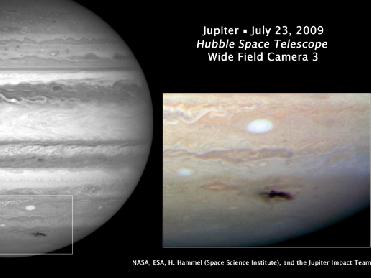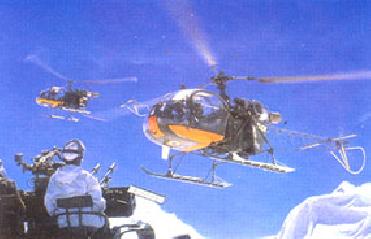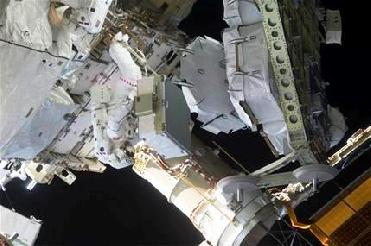
This picture, taken on July 23, by the Hubble's new Wide Field Camera 3, is the sharpest visible-light picture taken of the atmospheric debris from a comet or asteroid that collided with Jupiter on July 19. -- Image Credit: NASA
BALTIMORE (BNS): NASA's Hubble Space Telescope has taken a sharp, clear picture of atmospheric debris left behind following the collision of an object with Jupiter on July 19.
�Hubble's truly exquisite imaging capability has revealed an astonishing wealth of detail in the impact site,� Heidi Hammel at the Space Science Institute in Boulder, Colorado, said.
�By combining these images with our ground-based data at other wavelengths, our Hubble data will allow a comprehensive understanding of exactly what is happening to the impact debris,� Hammel said.
The spot was created when a small comet or asteroid plunged into Jupiter�s atmosphere and disintegrated. It was first detected by an Australian amateur astronomer.
The only other time a similar feature was detected on Jupiter was 15 years ago when fragments of comet Shoemaker-Levy 9 had collided with the mega planet, NASA said.
According to NASA, the diameter of the impacting object is estimated to be the size of several football fields. The force of explosion on Jupiter was thousands times more powerful than the suspected comet or asteroid collision that occurred over the Siberian Tunguska River Valley in June 1908.
�Because we believe this magnitude of impact is rare, we are very fortunate to see it with Hubble,� said Amy Simon-Miller of NASA's Goddard Space Flight Center in Greenbelt, Md. �Details seen in the Hubble view shows a lumpiness to the debris plume caused by turbulence in Jupiter's atmosphere,� he added.
The image was taken with the Wide Field Camera 3 fitted in the Hubble.
 Previous Article
Previous Article Next Article
Next Article












The Indian Air Force, in its flight trials evaluation report submitted before the Defence Ministry l..
view articleAn insight into the Medium Multi-Role Combat Aircraft competition...
view articleSky enthusiasts can now spot the International Space Station (ISS) commanded by Indian-American astr..
view article